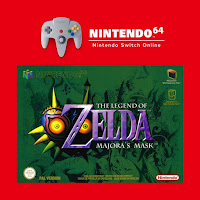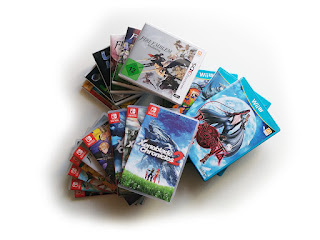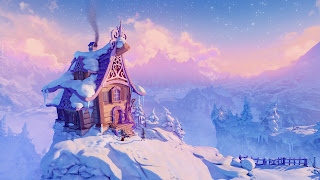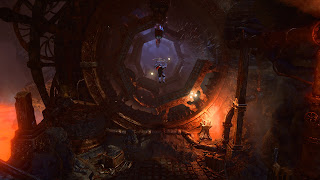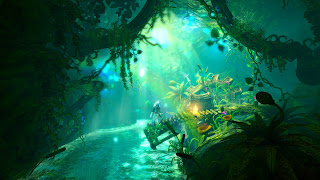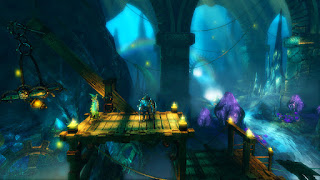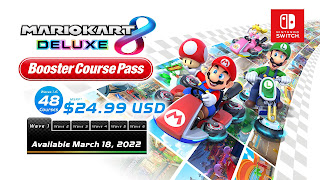Trine has been mentioned on this blog a couple of times, where now, after finally completing all four titles, it feels like the right time to offer a look at this particular Action Adventure series in more detail. Let's start by talking about the games in general and by discussing its first iteration, which originally came out in 2009. The other three titles will then be the subject of follow-up posts.
Series Overview
So, what is Trine? Developed by the Finnish indie studio Frozenbyte, Trine is a Fantasy Action Adventure and a level-based, side-scrolling platformer with focus on physic puzzles, where you play as three different characters. The stout knight Pontius fights with sword and shield, sometimes also with a hammer. The beautiful thief Zoya is skilled in archery and uses a grappling hook. And the fruitless wizard Amadeus can levitate objects through the air and also conjure objects of his own, mostly boxes and planks. Each of these characters has their own set of skills and strengths, where combining them is the key to success.

Their different abilities can (with the exception of the third game) be unlocked and upgraded by collecting experience points throughout the levels, which are usually found in the form of bottles or floating orbs in tricky places, but also by defeating enemies. Collecting all Experience in a level is often the real challenge, more so than just overcoming all the obstacles, where it may ask you to reach seemingly unreachable places. And this is where you truly have to test your puzzle solving skills by making best use of your current abilities of the three heroes.
For each puzzle and obstacle there are often a variety of different solutions, which makes this so much more enjoyable. This is a lot like in Breath of the Wild, but long before Breath of the Wild actually did it, where Trine always felt like an inspiration for the newest Zelda, at least when it comes to the usage of physics. But in the time before 2017, where Zelda games usually had just one (obvious) solution for their puzzles, Trine felt truly special. Whether you stack objects as the wizard, swing around as the thief, use brute force as the knight, or combine all their skills in clever ways, the game always stays interesting with its approach and also gains a lot of replay value with it.
It's not all just puzzling and platforming, however, where you'll also run into enemies regularly and usually have to defeat them all in order to advance, which offers the necessary action in this Action Adventure. Here the knight is normally the most useful, but not all is lost should one of the characters die, where depending on the game you can revive them via checkpoints or by standing next to where they have fallen.
The story is quite simple, but gets charmingly told like a fairy tale by a narrator at the beginning of each level. It revolves around the "Trine", one of three artifacts similar to the Triforce. It links the three heroes together and even gathers them to send them on new missions. While the threats are always serious, the very different characters and their interactions provide a lot of humor and charm. A central location to the story is the Astral Academy, where wizards learn their craftsmenship. This is where the three heroes first meet and also find the Trine.
What's absolutely fantastic in all the games is the soundtrack by Ari Pulkkinen, where the music is as beautiful as the games' visuals and accompanies the adventures with very fitting and mostly memorable tunes. Even if you don't want to play the games, you should listen to their soundtrack at least once.
The Trine games are available on all the common platforms, where for Nintendo fans the first two games are on the Wii U and the entire series on Nintendo Switch. The Wii U versions, however, have a much better button layout, which lets you jump with ZL in addition to A. This is crucial, because you need to be able to use the right stick for certain actions (mostly the knight's shield and the thief's bow) while jumping, which simply doesn't work well with the A button.
But for some reason Frozenbyte decided to change this on the Nintendo Switch and unlike the PC versions you can't change the button layout at all. Well, you can change it in the Nintendo Switch system settings and create a preset (or two, because the controls also changed after the second title), but that's quite inconvenient, especially if you want to play other games on the sidelines. So, this is a point of criticism that all those games have in common on the Nintendo Switch, where overall it's recommended to go with the PC versions, unless you want to do couch co-op.
The PC versions simply have the quickest and most precise controls. You can move objects or attach your grappling hook by simply clicking on the things, which is very easy. The Wii U versions also let you use the touchscreen, which can be also quite useful, at least for the wizard's action, but as already said, only the first two games are available here.
Cooperative play is also a big aspect of the series. You can play them in singleplayer just fine, but the real fun is playing this with one or two other people. This even lets you do things that wouldn't be possible in singleplayer, like holding a blank in the air as the wizard, while someone else works over it. With three players and fixed characters things can also get more challenging, though, because you always have to find a way for every character to make it past an obstacle. (Depending on the game, version and setup you can warp yourself to the other players in some form.)
And of course you have to find the right people for the job. Maybe you're someone who wants to discover every secret, but you're stuck with people who just want to rush to the end of a level. Or you're stuck with people who take forever for everything, while you just want to rush to the end of a level. So, sometimes it can also be refreshing to simply play the game for yourself at your own pace. Still, you want to give the different ways of playing these games a try.
As for my personal history with the Trine series, it all started in 2013 when I joined two fellow students while playing Trine 2 on the PC. One year later I got the first two games on the PC myself, but also on Wii U, where I've played with some other friends online, and fully completed both games on both systems. Last year a certain someone invited me to play through all four games on the Nintendo Switch in local co-op, but I also played through Trine 4 a second time alone on the PC, where I was finished just yesterday. So, with the exception of Trine 3, I've played through all the games multiple times in very different ways.
There is also a spin-off title, Nine Parchments, which lets you slip into the role of different students from the Astral Academy and gets played like a twin stick shooter from an overhead perspective. This blog series will only cover the main games, though, at least for now.
Trine: Enchanted Edition
In 2014 Frozenbyte has remastered their first Trine in the same engine as the second, making it look and feel much more similar. If you buy the game today, like on Steam or the Nintendo Switch, this will be what you get. It's probably a good idea to start with this title in any case, because it will look very underwhelming compared to the later games. It's not terrible, but far from the excellence of Trine 2 and Trine 4, which are without a doubt the two stars of the series. The game is actually still quite pretty and the soundtrack is nice
as well, but it's overall somewhat more dull and less memorable than
what the successor(s) had to offer.

Of course this isn't the fairest comparison, since the series had to start somewhere and many video games had humble beginnings, but keep this in mind when you play this game. The total of 15 levels often also feel a little bit similar, both visually and with their gameplay, where only the later levels stand out, but not exactly for the best reasons. Collecting all the Experience is also not all too challenging, where you will find most of it on your first try.
All of that wouldn't be so bad, but the game also comes with a couple of problems that were eliminated by Trine 2. One of them are the enemies, where in the first title you'll mostly encounter armed, undead skeletons, which may spawn everywhere. Even behind you. And sometimes in intervals of multiple seconds. When you think it's finally over, another skeleton might spawn nearby to annoy you.
Luckily, they don't spawn infinitely, but it keeps going long enough that it might interrupt you when you're already about to solve a puzzle. This was handled much better in Trine 2, but this was also already improved in the Enchanted Edition, which in addition removed the bats from the original game. Those were super hard to hit and could kill you very quickly, where you might have fought your way through an entire army of the undead, only to get defeated by a swarm of bats in the end...
Also, the knight doesn't fare too well in melee combat in this game, even though it's his specialty, and also lacks some better skills, where he feels somewhat useless. So, as a result, while playing a second time on the "Very Hard" difficulty for the Steam Achievements, I mainly resorted to using the wizard and thief. The latter can even use her grappling hook on all wooden surfaces, where there are a lot in the levels, making the singeplayer almost too easy. All of this was balanced much better in Trine 2.
Something that got removed in the later games entirely (expect Nine Parchments) is the energy bar, which limits the usage of magic, like conjuring items and fire arrows (that's the only special arrow type in the first Trine). You have to collect blue bottles or use checkpoints to refill it, which doesn't really add anything to the game. You can blast through everything with fire arrows and get enough energy back, so it doesn't prevent from becoming too overpowered. At the same time you may run out of magic while trying to build something with the wizard, which limits you for no good reason. If you run out, you either have to find another energy bottle or go back to the last checkpoint. It's pointless punishment and was certainly good riddance.
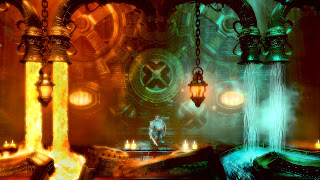
What also got removed with Trine 2, but actually was quite good, were the optional items. You can get those from chests, where two of those are hidden within in every level. The later games only offer "useless" collectibles, like paintings, poems, or decor, but Trine actually gives you different items with attributes, like armor, vials, or amulets. Those can raise your defense, your attack power, or even the number of arrows and magic objects, where both can go much higher than usual. Each character gets his or her own inventory with ten slots, where you have to decide who gets what. And this adds a little bit of an RPG element to the game, which is dearly missed in the other Trine titles.
In addition you'll find some major ability upgrades in chests at certain key points in the game. Those can be things like the Fire Arrows, the Hammer, or the ability to create planks, and are usually needed to progress through the game. The abilities then can be upgraded with the Experience that you've collected, where these upgrades are permanent, so you have to make a wise choice which one to boost next.
Conclusion
Trine was overall a solid first entry to the series, which really found its heights with the second game. Still, it's worth checking the first game despite its rough edges, where it even offers an interesting item system, unlike all its successors.

